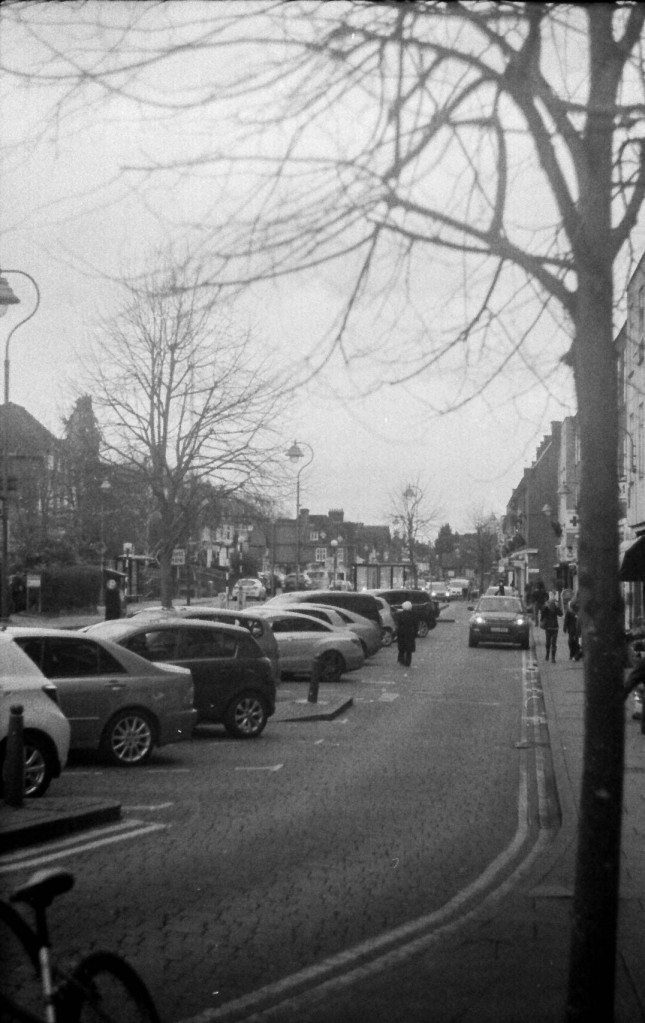As a few people have asked me about, I thought I’d put up a brief post on cross-processing C-41 film in B&W chemicals. I by no means claim to be an expert on this, so try it at your own risk! I can only talk about what I did. I apologise in advance if this post is boring and technical!
The film I shot was a Kodak ColorPlus 200 24 exp. film which expired in November 2014. This is just a cheap, C-41 colour film. I used standard Ilford B&W chemicals:
Ilfosol 3 Film Developer
Ilfostop Stop Bath
Ilford Rapid Fixer
I used a 35mm Paterson Super System 4 tank.
Before I started, I did some reading on cross processing. There wasn’t too much consensus across the net (surprise!). Some people said it was a waste of time, asserting that you’d only end up with a roll of fog, or very thin images. Other people seemed to produce good results doing it.
C-41 and B&W film have a different chemical make up. Again, I am no expert or chemist, but C-41 film has different dyes than B&W. Processing it involves steps that you don’t have in B&W, such as bleach fixing (blix) and stabilising. C-41 is also much more temperature sensitive than B&W. Apparently, even half a degree can make a huge difference when processing C-41.
B&W chemicals work best at about 20C, C-41 at about 39C, so this is a problem straight away. The way around this is to leave the film in the developer for longer. I came across the suggestion of doubling the developing time. This takes a bit of guess work as, of course, there are no suggested developing times for C-41 films in B&W chemicals! Turning to the trusty Massive Dev Chart, I found that the average developing time for ISO200 (Fomapan 200 for example) in Ilfosol 3 is about six minutes.
I doubled this to twelve minutes. I agitated the film for the first minute by rotating it in the tank, then did the same for ten seconds every minute. I then poured out the developer and poured in the stop bath for 30 seconds (as recommended on the bottle). The fixer recommends between two and five minutes – I went for the full five.
After that, I poured out the fixer (the film is now lightproof), and filled the tank with tap water. I let this stand for 45 minutes, poured that out and filled the tank with distilled water (my tap water is insanely hard). I agitated this constantly for two minutes before tipping it out and hanging the film in the bathroom for an hour to dry.
So, in a nutshell:
1. Develop for 12 minutes.
2. Stop Bath for 30 seconds.
3. Fix for five minutes.
4. Stand in water for 45 minutes.
5. Rinse in distilled water, agitating for two minutes.
6. Hang and wash again.
This left me with some useable prints. Here is one of the originals as it came from the scanner.
The other key difference with C-41 film to true B&W film, is that C-41 film comes on an orange ground, whereas B&W is clear. This is why the picture has an orange colour cast. This can cause problems if you plan to make your own prints in the darkroom, but isn’t too much of an issue if you’re scanning.
I popped the scan into Lightroom. Converting it from colour to B&W corrected the colour cast. All I then did was flip the image (yes, I scanned it back to front!) and upped the contrast to about +25. Here’s the final image. I’m sure it could be improved more in post, but I like to leave them as natural as possible.
I hope that was a semi-coherent account of what I did. Do drop me a comment if you have any questions! And, try it!



I’ve been waiting for some actual steps to follow. Awesome results. I’d like to try this on some colour film I have used. I’ll try your process.
LikeLike
Thanks very much. I think the key is to just keep experimenting until you get results you like. Good luck!
LikeLiked by 1 person